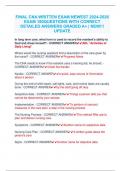Exam (elaborations)
TEST BANK Wong's Nursing Care of Infants and Children (12TH) by Marilyn J. Hockenberry Complete Guide Chapter 1-34| LATEST VERSION
Course
Nursing Care of Infants and Children
Institution
Nursing Care Of Infants And Children
TEST BANK Wong's Nursing Care of Infants and Children (12TH) by Marilyn J. Hockenberry Complete Guide Chapter 1-34| LATEST VERSION
[Show more]
Preview 4 out of 315 pages
Uploaded on
September 23, 2024
Number of pages
315
Written in
2024/2025
Type
Exam (elaborations)
Contains
Questions & answers
Institution
Nursing Care of Infants and Children
Course
Nursing Care of Infants and Children
$17.99
Also available in package deal from $49.86
100% satisfaction guarantee
Immediately available after payment
Both online and in PDF
No strings attached
Also available in package deal (1)
1. Exam (elaborations) - Test bank - for medical-surgical nursing concepts for clinical judgment and collabora...
2. Exam (elaborations) - Test bank concepts for nursing practice (4th ed) by jean giddens 2024 stuvia
3. Exam (elaborations) - Test bank wong's nursing care of infants and children (12th) by marilyn j. hockenberr...
4. Exam (elaborations) - Test bank for concepts for nursing practice (3rd ed) by jean giddens| complete guide ...
5. Exam (elaborations) - Test bank - community and public health nursing: evidence for practice 4th edition by...
6. Exam (elaborations) - Test bank for fundamentals of nursing 10th edition by by carol taylor, pamela lynn & ...
Show more
Wong's Nursing Care of Infants and Children 12th Edition by Hockenberry Test Bank





